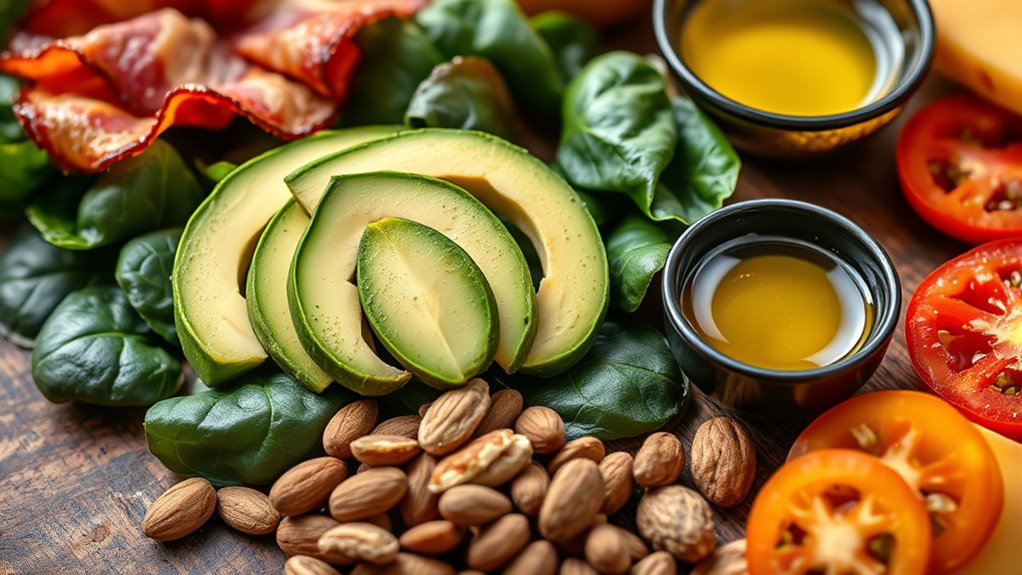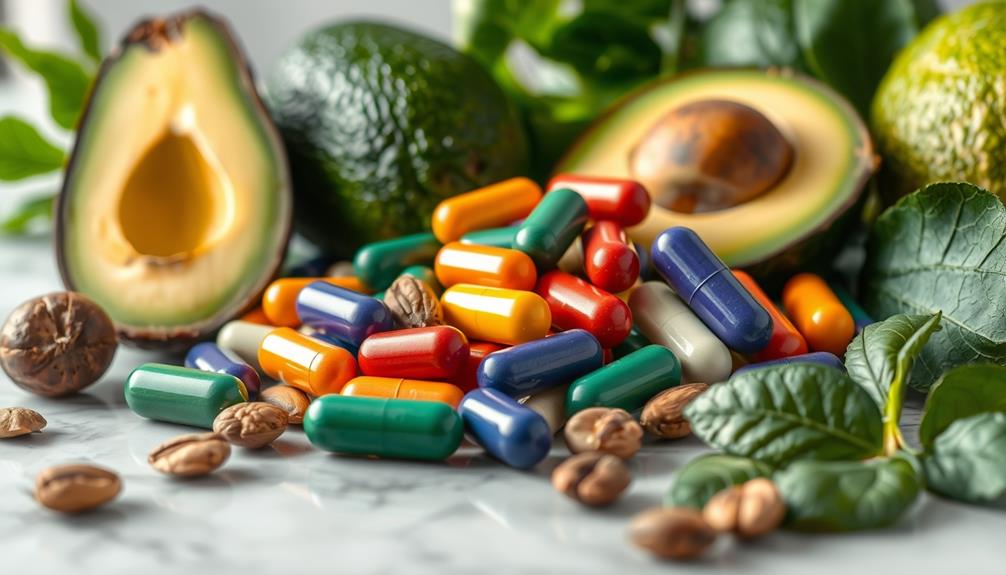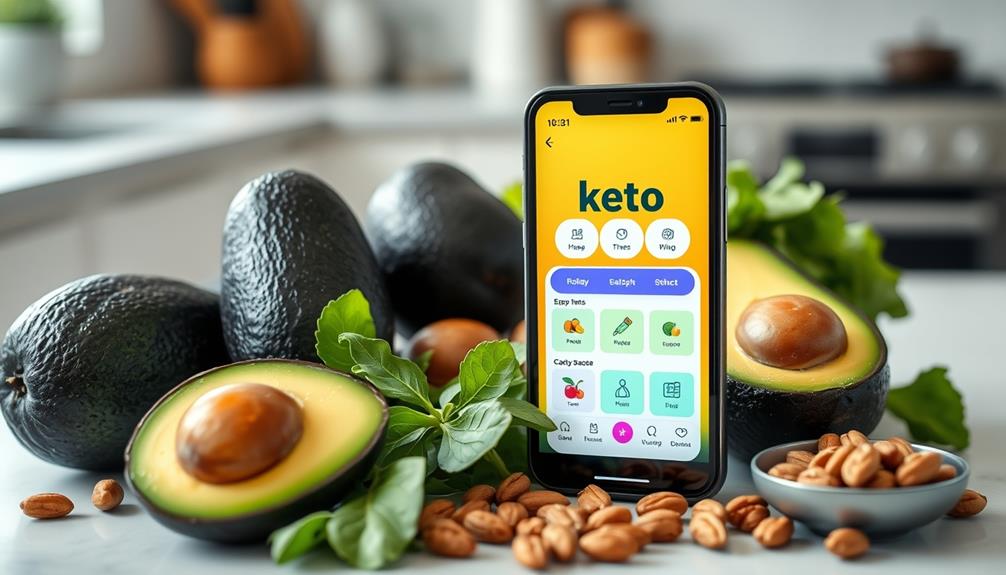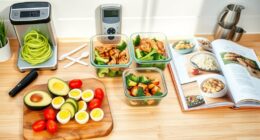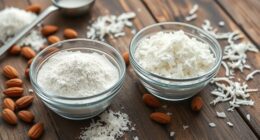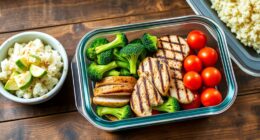On a keto diet, you can enjoy foods low in carbs and high in healthy fats, like nuts, seeds, cheese, hard-boiled eggs, and beef jerky. Include nutrient-dense options such as avocado, olive oil, and coconut oil, along with moderate protein sources like chicken, beef, and fish. Focus on low-carb vegetables like leafy greens and broccoli. Stick to these and you’ll stay in ketosis—stick around to learn more about creating tasty, compliant meals.
Key Takeaways
- Focus on low-carb, nutrient-dense foods like leafy greens, broccoli, and cauliflower.
- Include healthy fats from olive oil, avocado, and coconut oil to support ketosis.
- Consume moderate amounts of protein from chicken, beef, fish, eggs, and cheese.
- Snack on nuts, seeds, cheese, and beef jerky for portability and satiety.
- Limit or avoid high-carb foods such as bread, pasta, grains, sugary snacks, and processed foods.
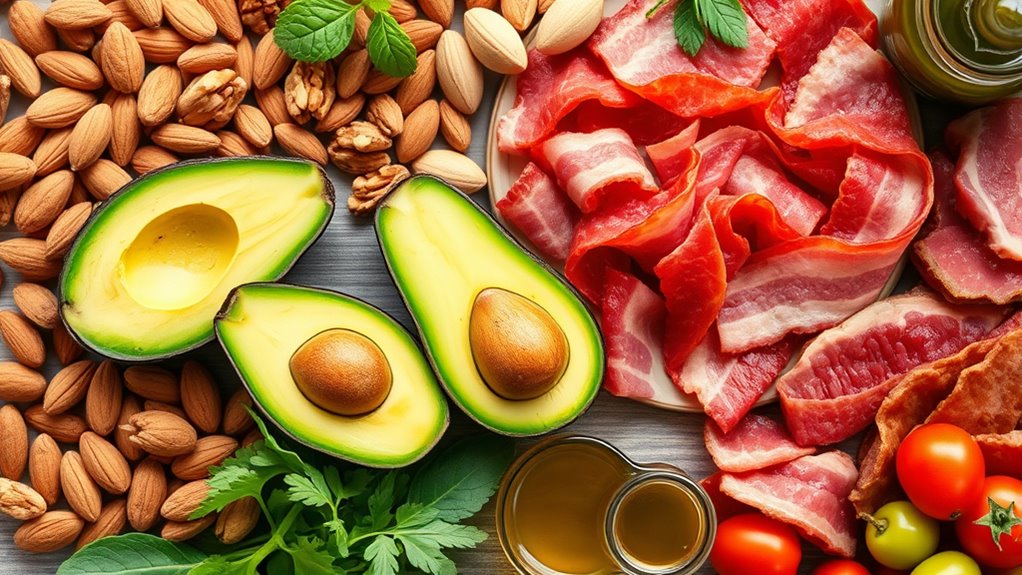
Starting a keto diet means focusing on foods that are low in carbs and high in healthy fats. It’s a lifestyle that encourages your body to burn fat for fuel instead of carbs. To succeed, you need to know which foods fit into this plan and how to incorporate them into your daily routine. When it comes to snacks, keto friendly snacks are your best bet for staying satisfied between meals. Think about nuts, seeds, cheese, hard-boiled eggs, or even beef jerky. These options are portable, satisfying, and help you avoid high-carb temptations. Planning ahead with these snacks can make a huge difference, especially if you’re often on the go.
Meal prep tips are also essential for sticking to your keto goals. Preparing meals in advance means you’re less likely to reach for high-carb convenience foods when hunger strikes. Focus on batch-cooking proteins like chicken, beef, or fish, and pairing them with low-carb vegetables such as spinach, broccoli, or cauliflower. Incorporate healthy fats from sources like olive oil, avocado, and coconut oil to add flavor and satiety to your meals. When planning your prep, keep it simple and versatile—roasted veggies, grilled meats, or egg-based dishes can be mixed and matched throughout the week to prevent boredom. This way, you can easily assemble keto-friendly meals without spending too much time cooking every day. Using nutrient-dense foods can help ensure you meet your nutritional needs while maintaining ketosis.
Fats should be your primary energy source on a keto diet, so include plenty of healthy options like avocado, nuts, seeds, and fatty fish such as salmon. Dairy products like cheese, Greek yogurt, and butter are also great for adding flavor and fat to your meals. Meanwhile, you’ll want to limit or avoid high-carb foods such as bread, pasta, grains, and sugary snacks. Instead, focus on leafy greens, cruciferous vegetables, and low-carb berries if you crave something sweet. Remember, reading labels is essential because many processed foods contain hidden sugars or carbs that can kick you out of ketosis.
Frequently Asked Questions
Can I Eat Fruit on a Keto Diet?
You can eat some fruit on a keto diet, but you need to watch the fruit carbs. Opt for low-carb fruit varieties like berries, such as strawberries, raspberries, and blackberries, which have fewer carbs than other fruits. Limit your servings to stay within your daily carb limit. Avoid high-sugar fruits like bananas, grapes, and mangoes, as they can kick you out of ketosis. Stick to small portions of these keto-friendly fruit varieties.
Are Low-Fat Foods Suitable for Keto?
Low-fat foods aren’t ideal for keto meal planning because they often contain higher carbs or sugars. Instead, focus on healthy fats and moderate protein to stay in ketosis. For keto snack options, choose full-fat cheeses, nuts, or seeds. These keep you full longer and support your keto goals. Remember, selecting nutrient-dense, high-fat foods helps you maintain ketosis and makes your overall keto experience more effective.
How Much Protein Is Recommended Daily?
Your protein intake should be like a steady stream—focused and consistent. Generally, you need about 0.6 to 1 gram of protein per pound of body weight daily, depending on your activity level. Your daily requirements vary based on your goals and health, but aim for enough to support muscle maintenance without kicking you out of ketosis. Adjust your intake as needed, listening to your body’s signals.
Is Alcohol Allowed on a Keto Diet?
Yes, alcohol is allowed on a keto diet, but you should choose keto-friendly beverages to avoid knocking yourself out of ketosis. Keep in mind that alcohol metabolism slows down on keto, so it can affect your progress. Stick to lower-carb options like spirits (vodka, gin), dry wines, or light beers. Always drink in moderation, and be mindful of how alcohol impacts your body’s ability to stay in ketosis.
Can I Eat Dairy Products in Unlimited Amounts?
You can’t eat dairy products in unlimited amounts, even if dairy fat and lactose content tempt you. Ironically, while cheese and cream are keto-friendly, overdoing it can kick you out of ketosis. Moderation is key with dairy, as excessive intake may stall weight loss or cause digestive issues. So, enjoy your dairy, but keep portion sizes in check to stay on track with your keto goals.
Conclusion
Now that you know what to eat on a keto diet, you’re ready to hit the ground running. Stick to these foods, and you’ll be well on your way to reaching your goals. Remember, Rome wasn’t built in a day, so be patient and stay consistent. Keep your eyes on the prize, and soon enough, you’ll see the results you’re after. Stay committed, and you’ll turn the tide in your favor.
